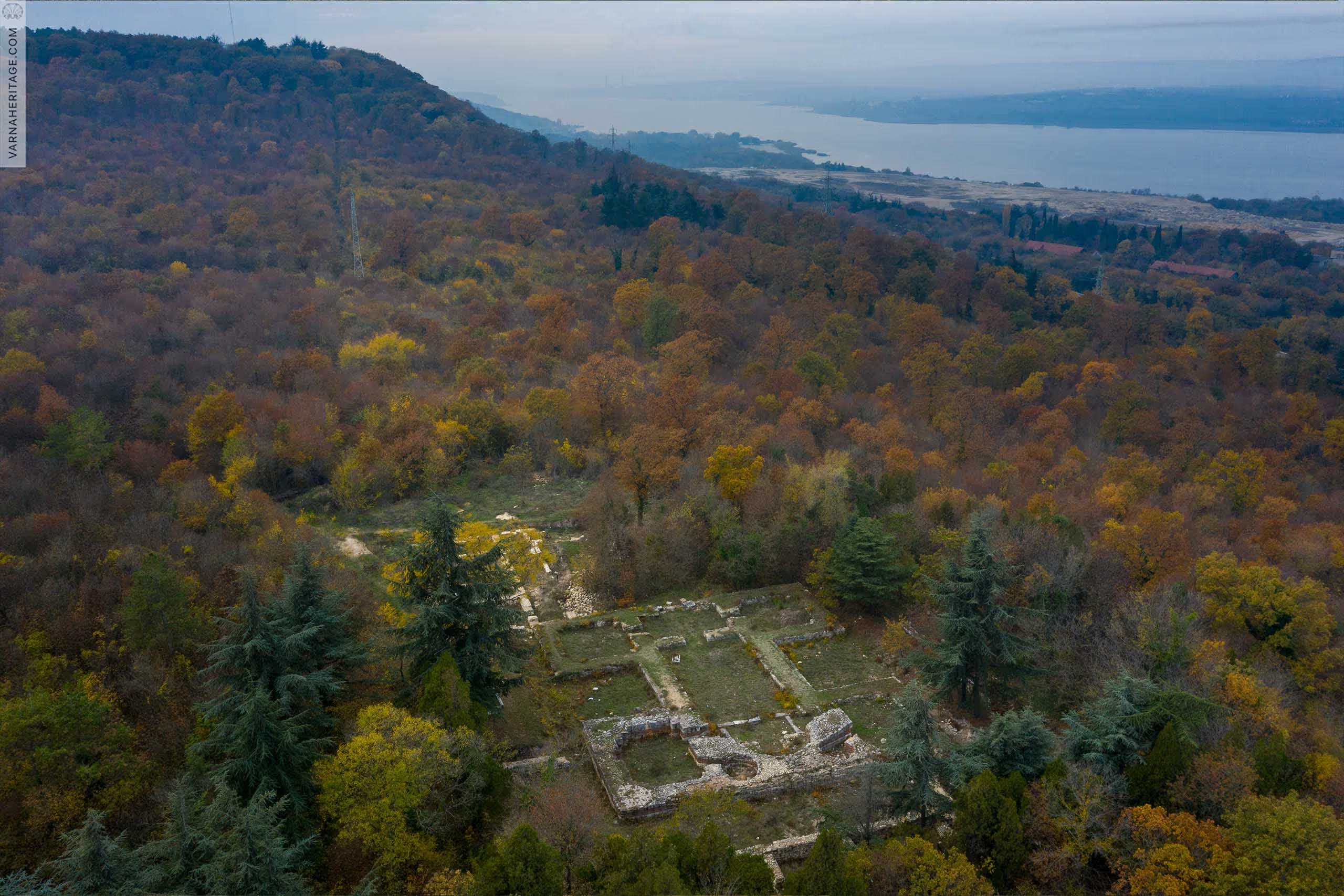
Датировка
The beginning of the 6th century
Кратка информация
The early Christian balisika is a unique example of church architecture in Bulgaria from the beginning of the 6th century. It is located in the district of Asparuhovo in the area of Dzhanavara (Dzhanavar-tepe). The dating was established by Al. Minchev based on the discovered mosaics. To this day, they are still in place (in situ). Their total area is considerable - about 120 square meters. About 100 square meters have been preserved, in relatively good condition, although cracks and damage from modern mining excavations and overgrown plant roots have been found in places.
The plan of the building is unique for Bulgaria. It is a single-nave basilica, with a single-part narthex and an atrium with a colonnade. The internal semicircular apse built into the eastern wall is also unique. The total dimensions of the temple are 31 meters - length and 28 meters - width, with a thickness of the walls of the nave 2.5 meters. It is built of alternating belts of cut stone blocks and bricks with a joint of mortar and battered bricks. Two symmetrical rooms were added to the east and west corners of the nave. The eastern ones are rectangular and the western ones almost square.
The baptismal font (baptisterium) is located in the northwest, and in the middle a cruciform piscina has been revealed. The eastern rooms probably played the role of pastophoria - diakonicon and prothesis. They were two-story and their second floors simultaneously played the role of solid defensive towers. They were accessed through specially built circular rooms in the eastern wall near the apse with curved masonry stairs leading to the second floor of each tower. The apse has a two-step syntron, and only the main stones of the marble altar partition have been preserved. In the middle of the naos there was a marble pulpit, the base of which was discovered during the excavations of the Shkorpil brothers.
During the excavations of the Varna Archaeological Society in 1915 and 1919, a 5-meter mound, called "Ilan Tepe" or snake mound, was excavated consecutively. Under it, the Shkorpil brothers discovered "foundations of an early Christian, single-nave basilica (temple), with beautiful mosaics and a baptistery." (IVAD - 1921, 59). Already at the opening of the basilica, the Shkopril brothers discovered a shaft between the pulpit and the altar, which has access to the reliquary to the east and to a rectangular vaulted tomb to the west. From the reliquary they take out a white alabaster box in the shape of a sarcophagus. In it there is a silver sarcophagus, in which they find a third box - gold, decorated with precious stones, in which there are relics of an unknown saint and a piece of rotten wood. A small and a large linden coffin with human remains were found in the tomb. After the death of Hermengild Shkorpil (1923), who was a leading figure in the study of the site, a large part of the information remained unpublished, and the excavations were suspended.
In the 1960s, a partial conservation and restoration of the site was carried out.
At the end of the 1990s, the archaeologist Al. Minchev renewed the excavations and made significant discoveries, as well as precise dating of the basilica. Due to lack of financing, planned excavations on the site have been suspended again.
According to data from the annual reports from "Archaeological discoveries and excavations", it is clear that teams of the Regional History Museum - Varna carry out annual excavations and conservation activities on the site. Gradually, the entire plan scheme of the basilica was revealed and preserved. The hypotheses about the presence of a monastery in the immediate vicinity of the temple are also confirmed. There is an assumption that the monastery complex served the emigrant colony from the eastern provinces in Odessos, most likely Monophysite.
Studies of the monastery complex continue and gradually new artifacts and information are revealed. The site has been proposed for granting the status of national importance.
Местоположение
area "Dzhanavara tepe“ /Ilan tepe/, Arsparuhovo district
Културна пренадлежност
Byzantine culture
Проучване
1915 - 1921 - K. and H. Shkrpil; The 60s of the XX century. - Team of regional historical museum - Varna; 1997 - 1999 – Ph.D. Dr. Al. Minchev; from 2006 - associate professor Dr. Al. Minchev, Ch. Assistant Dr. V. Tenekejiev
Техническо състояние
Good technical condition
Статут /описан в АКБ/
National importance / State gazete 16/27.02.1968/
Режим на опазване /съгласно чл.35 от НАРЕДБА №7/
А
Подобни обекти

Knyaz Boris Blvd., Nezavisimost Square, Odessos Archaeological Reserve, Varna

9 "Sofroniy Vrachanski" St., "Odessos" Archaeological Reserve, Varna

Between Chopin Street and Nezavisimost Square, bordering the Archaeological Reserve "Odessos", Varna

"Khan Krum" St., on the corner with "Kn. Al. Battenberg" St., Archaeological Reserve "Odessos", Varna

Western Industrial Zone, Varna

Pirinch Tepe area, on the island area under Asparuhov bridge, in the yard of Ship Repair Plant, Varna



































%20copy.avif)
